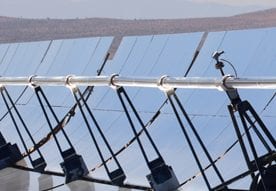The South Australia city of Port Augusta may be a long way from getting the solar thermal power station it craves, but it may soon host a world-leading technology that uses solar thermal energy to power a huge greenhouse to grow food in the desert.
Sundrop Farms, which has built a pilot station (we wrote about it here) featuring its unique technology that uses solar thermal energy to desalinate water for irrigation, and for heating and cooling, has secured finance from the Clean Energy Finance Corporation to build a 20 hectare commercial greenhouse around 10kms south of the city.
The massive greenhouse will feature concentrated solar power technology – most likely a parabolic trough array that will deliver around 36MWth (megawatt thermal) of energy. This will make it the largest stand alone CSP arrays in the country. The overall project cost has not been revealed but is believed to be at least $100 million. It will employ more than 200 people.
Port Augusta has been fighting to have its ageing and polluting coal-fired power stations replaced by concentrated solar thermal technologies to produce electricity.
The 20-hectare greenhouse facility will produce over 15,000 tonnes of tomatoes a year for metropolitan markets across Australia, and the company hopes it will be the fore-runner of many more projects in Australia and other desert regions, particularly in the Middle East and north Africa.
The technology is similar to that featured in another project in Qatar that RenewEconomy reported on last year. Indeed, SunDrop advised on that technology. But while that Qatari project was funded with development funds from Norway, the Port Augusta project will be funded on a commercial basis.
Sundrop Farms founder and CEO Philipp Saumweber, a former Goldman Sachs banker, said the CEFC commitment would provide an important foundation for the project, and would facilitate investment from other banks. The CEFC funding would be for about one quarter of the project.
CEFC CEO Oliver Yates said the finance was an example of the sort of technologies that the CEFC could support to transform the Australian economy and create new industries in regional areas.
“Once implemented, this project would be a worldwide demonstration of sustainable horticulture practices that address growing food security, water and clean energy challenges,” he said in a statement.
“Australia is starting to embrace the opportunities clean energy technology can provide, and to appreciate how these technologies can be applied across many sectors of the economy from farming through to manufacturing.”
Sundrop Farms chief strategy officer David Carew said the solar thermal array would provide virtually all the energy requirements of the greenhouse. It was a perfect technology for areas with sun, poor land and little water. Around 12MWth would be used to desalinate the water, and a further 24MWth will be used for the greenhouse.
“These greenhouses require a very large amount of energy. A greenhouse is a climate controlled chamber, so in cold desert nights or hot desert days you’ve got to keep it warm, or keep it cool,” Carew told RenewEconomy in an interview. He said the system is designed to be self-sufficient in energy, although in Port Augusta it also has the luxury of grid back-up, and was one of the few spots in Australia that had excellent solar radiation and high humidity levels.
“This is really Australia at its best,” Carew said. “It is an Australian creation, it has been trialled here, developed here, it’s got great support from the SA government, which has really listened to us and given us the benefit of the doubt.
“It has got quality funding, it has got a strong market for the produce, and in South Australia we have got long-established horticultural expertise, so with the mixture of that horticultural expertise, our solar and renewable and water expertise, we can raise the Australian flag and help other countries that have got serious food concerns.








